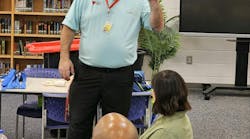Many years ago when the original Gangs of New York held court in the Bowery, the tough, no-nonsense volunteer firefighters of Tammany Hall fought the red devil and prevailed. One of the homespun heroes of the time was known as 'Fire Fight'n Mose."
Born in a firefighter's helmet, he pulled the engines single-handedly as he leaped to second story buildings to save citizens from the flames using a long pole that soon became the standard sliding pole in the fire stations of New York. He was bigger than life and commanded respect through his deeds of daring. He was a leader.
The story of Mose is an example of leadership through story telling: one of the oldest and most effective methods of marketing in the world. The human species is "hard-wired" to understand the world through stories. And, of course, Walt Disney was one of the greatest story tellers of all time. As many of you know, in 2005 Liberty Mutual Insurance and the Disney Imagineers at Epcot created an interactive fire education experience called to educate our thousands of guests about safe behaviors should they be caught in a fire.
Just a couple of years ago, we heard a story from one of our cast members who noted that four families had come to Epcot just to see the fire education experience because a young girl in one of the families had saved herself and four other girls at a neighbor's sleepover, largely because of the lessons learned at "Where's the Fire?. You can imagine the response of our cast members. They were pumped and highly motivated to continue the great job they already perform.
Leadership is Communications and Relationships
The academic guru of leadership, Warren Bennis, noted some years ago that there are too few leaders in the world today and none on the horizon. It is true that we know our leaders through their actions, but leaders have the responsibility to lead their organizations by gaining consensus and passion to achieve their department's mission. If you do not have a relationship with your firefighters and officers as well as your citizens, you already have one hand tied behind your back.
It's always about the relationship. The average American citizen continues to receive approximately 4,000 messages annually in some advertising format according to the American Advertising Association. Now, add to this the multiple distractions we seem to endure daily and you begin to see the difficulty in getting our message across. The fire service is a natural repository of leadership because of the dynamic and critical nature of the mission. If one couples the positive position we occupy in our citizens' minds with our usually high visibility, one can see the opportunities for spreading our mission to lower the fire rate in our communities.
We must be able to communicate effectively in large and small groups to get the message across effectively. This means telling a story well to our citizens for their own safety and to our firefighters to hone their skills. You may not be able to achieve the goal of moving citizens to safer behaviors every time, but you do have the opportunity to stimulate thought and conversation about fire safety. This can help inspire them to the higher purpose of responsibility and saving their own lives. There are three key elements that comprise this skill and they are just as critical to marketing communication as they are to leadership: gaining trust, creating a vision and inspiring action.
Who are You and How Much do You Care?
One of the most important skills in gaining trust is developing a platform for empathy and like-mindedness. This means connecting with the group you are addressing so that each member knows that you are an expert in the subject matter and its applications. But there is another factor: your ability to communicate to the group the empathy you hold for each of them.
Marsha Gay Harden, the Oscar-winning actress is the spokesperson for Liberty Mutual's public fire education efforts through her public speaking, writing and on Liberty's website, BeFireSmart.com. Unfortunately, she lost dear members of her extended family in a house fire some years ago. She speaks from the heart, from the experience of one who has endured the tragedy many of us have witnessed. When she speaks about fire prevention, her audience listens. She has created the bridge of empathy; she has qualified herself. We have all heard it before: "It doesn't matter how many years of experience and knowledge you may have in a particular field, your audience will not care a jot about how much you know until they know that you care." Consistently search for ways to build the links of empathy and you will create the trust that will open you audience's mind for the message.
Create a Picture
The second critical skill is the ability to create a vision in the mind of the audience. If we are teaching a small group about safe behaviors in a fire it might be describing "the fire that didn't happen" because of the preventative actions that the group took before each member found themselves in the emergency situation.
Think about how many times we go through evolution after evolution in learning a new skill or tool. The purpose for almost all of our training is so that our actions become second nature when we really need to use the skill. It's the same way when describing preventative actions to a group of citizens. But is that the way the citizen understands the actions they need to take at the appropriate time? One way to assure this is to show how their safe future can come closer to reality if they practice the behaviors we are suggesting.
This same approach applies to leadership. Creating a compelling future for your department or your team that breaks down the worn out paradigms requires the dynamism of a leader who understands where you are now, how to get to that new place and what that place will look like when you have arrived. It is not always necessary for a leader to have come up through the ranks to articulate the mission and paint the vision for a great department as long as you know that the leader believes it with every fiber of his or her being. Frank Brannigan, the world-renowned expert in building construction and collapse for the fire service was never a firefighter or a fire chief, but he has influenced generations of firefighters, saving not only their lives but countless lives of our citizens through his many textbooks, instructional manuals, seminars and direction. His driving passion was his love for the fire service and fire protection. And his vision articulated communities with safe construction practices throughout the world.
Just Do it!
The final and most critical element of leadership communication is in inspiring action. This step is the one that I cannot emphasize enough. A mentor of mine and one of the most effective leaders in the history of the Walt Disney Company always said, "A leader's job is to do what has to be done, in the way it should be done, whether he or she likes it or not." There is not a firefighter today who does not understand that statement.
In many other fields and occupations, mediocrity can gain ground because, perhaps, in their minds the actions they should take are not that important. In our profession, lives are at stake. The margin of error is very small. This means that when we communicate we want to be as certain as we can that our actions define us and our vision.
It is also why that, as a profession, we are in a position to influence our department for the maintenance of our citizens' safety. The United States continues its reputation as having one of the worst records of loss to fire in the civilized world. Changing the paradigm of how the fire service approaches the fire problem will require an understanding of how we can communicate our vision of a fire-safe country to ourselves first so we can save the lives of future generations. How? Picture thousands of fires...that will never happen.
BEN MAY, a Firehouse.com Contributing Editor,has been developing the discipline of fire and emergency services marketing management for the past 15 years. He has been a firefighter for Montgomery County, MD, Fire and Rescue and fire commissioner for the Woodinville, WA, Fire and Life Safety District. He has been a vice president of two international marketing firms over the last 25 years, and now is responsible for business development for Epcot at Walt Disney World Resort. To read Ben's complete biography and view their archived articles, click here. You can reach Jameson by e-mail at [email protected].





